Colors, like features, follow the changes of the emotions.
🎨🎨🎨🎨🎨🎨🎨🎨🎨🎨🎨🎨
Spoken like a true ARTIST! Pablo Picasso was one of the best and way ahead of his time during his time period. His works of art are undeciphered and unique today just as it was back in the 1800s-1900s. I agree with that quote especially when it comes to the art work that is seen flowing through the cannabis industry. I can't help but feel like the collaborators of marijuana art work aren't appreciated nearly as enough as they should be. But art is life and can be found everywhere as long as you look for them in the right places.
For this post, I'll be going over my top 3 cannabis companies and products that really POP when it comes to the use of art in their medical marijuana advertisements. I'll also be touching on a few of my favorite products and packaging devices that I would personally put in on display in a museum if given the chance. You may be familiar with some and unfamiliar with others. But that's the beauty of art - You learn as you go and you learn new things. Here's a couple of my top favorite pieces of art via the medical marijuana industry:
1. JELLY CO - BAY AREA
Jelly Co spans from the Bay Area in California and has been a huge pioneer in the cannabis industry. Aside from all the healthy green products they offer, they never fail to weave in their amazing artwork that looks like something out of a coloring book. What I like the most about their approach to art is how comical it comes off as, bringing back childhood nostalgia with a beautiful array of colors that you would find on the rainbow itself. Jelly Co is definitely one of my top favorites when it comes to art usage. (Links to social media included).
Instagram 📸 https://www.instagram.com/jellyco.brand1/
Bettys Eddies are a big time favorite of mine based off the quality and taste of their products. The taste of edibles and fruit chews with natural flavor is friendly enough for the most premature of cannabis enthusiast. However, what I like the most about Bettys Eddies is their natural and soft approach to the art work used with their products. It speaks to how much pride they have in not only their products but their brand being an overall organic leader in the cannabis industry. I'll display a few pieces and include the social media links:
https://www.instagram.com/bettyseddiesofficial/:
📸
<------------
https://twitter.com/bettyseddies:
🐦 --------->






Comments
Post a Comment